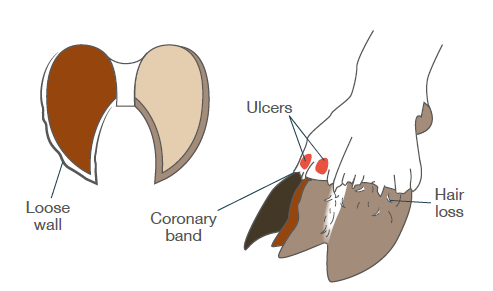- Home
- Knowledge library
- Diseases that cause lameness in sheep: CODD (contagious ovine digital dermatitis)
Diseases that cause lameness in sheep: CODD (contagious ovine digital dermatitis)
Find out how to prevent this infectious disease and treat it quickly if it occurs.
Back to: Reducing lameness in sheep
Signs
- CODD initially occurs at the top of the hoof (coronary band) and often results in severe lameness
- Infection starts as a small ulcerated area at the coronary band
- The infection progresses to under-run the hoof horn capsule downwards towards the toe
- The whole horn capsule may fall off
There can be severe outbreaks of CODD in which up to 50% of a flock – both adults and lambs – may be affected in the first year. CODD infections may set lambs back for several weeks or months. The following year, outbreaks are usually less severe. Mixed infections of both CODD and footrot are found on some farms.

Cause
While several bacteria can be isolated from infected hooves, it is considered that Treponema spp. are responsible for CODD.
A risk factor for CODD is co-infection with footrot and therefore control of footrot should help reduce the risk of CODD on affected farms
Treatment
It is essential to seek veterinary advice for the latest recommendations as soon as CODD is suspected. Treatment options include injectable long-acting antibiotics and antibiotic spray (may require repeat treatment). Do not trim the foot, because there is risk of damage to underlying tissues and spread of infectious material on equipment/hands. There is a strong link between footrot and CODD; therefore, it is recommended to implement the five-point plan to aid the control of CODD.
Find out more about the five-point plan for treating lameness.
Prevention
The greatest risk is posed by purchased sheep, which may not appear lame but can be carriers.
- Carefully check the vendor’s flock history and buy from flocks that are free from CODD
- Turn-over and inspect the feet of all returning or bought-in sheep, because many sheep with early CODD lesions are not lame and can introduce disease
- Quarantine purchased and returning stock for at least 28 days. If possible, separate for longer
Disinfecting and cleaning
Hands, gloves and trimming knives become covered in the infectious agents during handling/trimming feet (hence trimming not advised). Clean hands and disinfect trimming tools between feet. Research has shown that 1% FAM30®, 2% Virkon® or 2% sodium hypochlorite are effective at preventing visible growth of treponemes following 20 seconds of contact.

